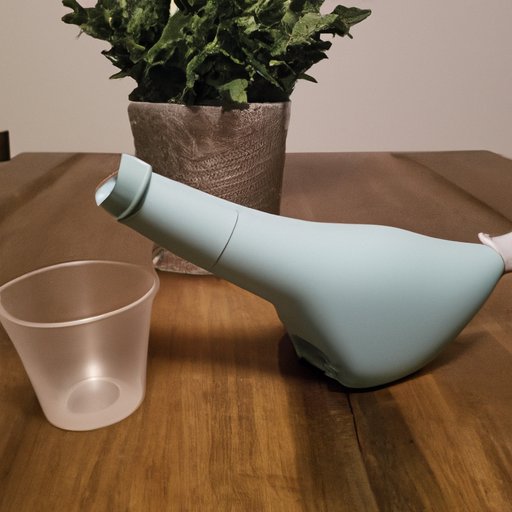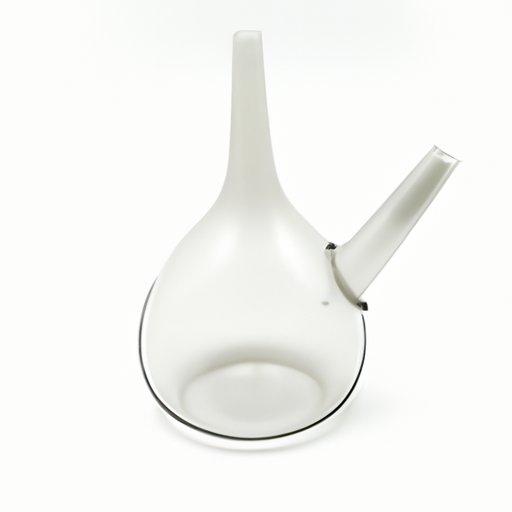Introduction
If you suffer from allergies, sinus infections, or other respiratory issues, you’ve probably heard of a neti pot. A neti pot is a small teapot-shaped device used to irrigate the nasal passages with a saline solution. It has been used for centuries in Ayurvedic medicine and has gained popularity in recent years as a natural remedy for respiratory problems. In this article, we’ll explore the basics of using a neti pot, how to choose the right one for your needs, and how to incorporate it into your daily wellness routine.
Basic Guide to Using a Neti Pot for Beginners
If you’re new to neti potting, it’s important to understand how to use it properly to maximize its benefits and avoid common mistakes. Here’s a step-by-step guide:
- First, fill your neti pot with warm water. Water that’s too hot or too cold can cause discomfort and even damage to your nasal passages.
- Add a teaspoon of salt to the water and stir until it dissolves. You can also use pre-packaged saline rinses available in drug stores.
- Stand over a sink or in the shower, tilt your head to one side, and insert the spout of the neti pot into your upper nostril.
- Tilt the neti pot so that the water flows into your nostril and out the other nostril. Breathe through your mouth.
- Switch sides and repeat the process on the other nostril.
It may take a few tries to get used to the sensation of water flowing through your sinuses, but it shouldn’t hurt or feel uncomfortable. If you experience pain or discomfort, stop and adjust your technique.
Common mistakes that beginners make include using too much salt, not using enough water, and using tap water instead of distilled or boiled water. Make sure to follow the instructions carefully and use sterile water to avoid infection or irritation.
Comparing Different Types of Neti Pots and Which is Best for You
There are several types of neti pots available in the market, each with its own benefits and drawbacks. Here’s an overview:
- Ceramic: Ceramic neti pots are reusable and come in various sizes and shapes. They are easy to clean and can last for years. However, they can be fragile and break if dropped.
- Plastic: Plastic neti pots are lightweight, unbreakable, and often come with extra features such as temperature control and squeeze bottles for better control of the flow of water. However, they may not last as long as ceramic pots and can be prone to mold and bacterial buildup.
- Glass: Glass neti pots are transparent, easy to clean, and non-reactive. They are also more eco-friendly than plastic or ceramic pots. However, they can be expensive and fragile.
When choosing a neti pot, consider your budget, durability needs, and personal preferences. It’s important to choose a pot that you’re comfortable using and can maintain easily for optimal safety and effectiveness.
How to Clean and Maintain Your Neti Pot for Maximum Safety and Effectiveness
Neti pots can harbor bacteria and other pathogens if not cleaned and maintained properly. Here’s how to keep your neti pot in good condition:
- After each use, rinse your neti pot with distilled or boiled water and let it air dry.
- Once a week, sanitize your neti pot by soaking it in a solution of one part white vinegar to three parts water for 5-10 minutes.
- Replace your neti pot every six months to one year, depending on the material and frequency of use.
Following these steps will ensure that your neti pot is free of harmful bacteria and other contaminants that can cause infection or irritation.
Tips for Comfortable and Effective Neti Pot Use
While neti potting is generally safe and effective, there are some common problems that people encounter. Here are some tips for minimizing discomfort and maximizing effectiveness:
- Use warm water and the correct amount of salt. Too much salt or water that’s too hot or too cold can cause discomfort or irritation.
- Use a comfortable posture and breathe through your mouth to avoid choking or gagging.
- Adjust the angle of the pot or the position of your head to maximize the flow of water through your sinuses.
Everyone’s anatomy is different, so it may take some experimentation to find the most comfortable and effective technique for you.
What to Do If You Experience Discomfort or Complications While Using a Neti Pot
While neti potting is generally safe, there are some complications that can occur, especially if you’re not following the instructions properly. Here are some warning signs to watch out for:
- Pain or discomfort in the sinuses or ears
- Feeling dizzy or lightheaded
- Coughing, sneezing, or gagging excessively
- Bleeding from the nose
If you experience any of these symptoms, stop using the neti pot immediately and seek medical attention if necessary.

Using a Neti Pot to Alleviate Seasonal Allergies and Congestion
One of the most common reasons people use a neti pot is to alleviate allergies and congestion. Here’s how neti potting can help:
- Flushing out allergens, pollutants, and other irritants from the sinuses
- Reducing inflammation and swelling in the nasal passages
- Moisturizing dry nasal passages to prevent cracking and bleeding
If you suffer from seasonal allergies or other respiratory problems, incorporating neti potting into your daily routine can be a natural and effective way to manage your symptoms. You can also complement your neti pot usage with other natural remedies such as steam inhalation, herbal teas, and aromatherapy.
Incorporating a Neti Pot into Your Daily Wellness Routine
Using a neti pot can be a simple and effective way to promote overall nasal health and wellness. Here’s how you can fit it into your daily routine:
- Use it in the morning and at night to clear congestion and promote better breathing
- Incorporate it into your self-care routine, such as after a yoga practice or meditation session
- Take it with you when you travel to counteract the effects of dry air and other environmental irritants
By using a neti pot regularly and as part of a comprehensive self-care regimen, you can improve your respiratory health and overall well-being.
Conclusion
Using a neti pot is a simple and effective way to promote nasal health and relieve respiratory symptoms. By following the basics of neti potting, choosing the right pot for your needs, maintaining it properly, and incorporating it into your daily routine, you can experience optimal benefits with minimal risks. Remember to always consult with your healthcare provider if you have any concerns or experience any complications.
